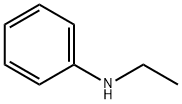N-에틸아닐린 C화학적 특성, 용도, 생산
화학적 성질
N-Ethylaniline is yellow-brown oil with a
weak fishy odor.
출처
Polyethylene bottles used in intravenous solutions have been reported to be contaminated with N-ethylaniline from rubber parts of the closure (Ulsaker and Teien 1979). It has been reported that rubber containing N,N
,-dithiodimorpholine accelerator of vulcanization can release N-ethylaniline into an aqueous media (Stankevich and Shurupova 1976). This compound has also been reported as a contaminant of cigarette smoke at a level of 55.8 ng per one U.S. 85 mm cigarette (Patrianakos and Hoffmann 1979).
용도
N-Ethylaniline is used as an explosive stabilizer and in
dyestuff manufacture.
생산 방법
Manufacture of N-ethylaniline is based on the reaction of aniline with alkyl halide or by heating aniline with ethyl alcohol under acidic conditions followed by purification (Windholz et al 1983).
일반 설명
A dark liquid with an aromatic odor. Insoluble in water. Density 0.963 g / cm3. Toxic by skin absorption and inhalation of vapors. Evolves toxic fumes during combustion. Flash point 185°F.
공기와 물의 반응
Unstable to prolonged exposure to air and/or light. Insoluble in water.
반응 프로필
N-Ethylaniline may react violently with nitric acid. May react with strong oxidizing agents. . Neutralizes acids in exothermic reactions to form salts plus water. May be incompatible with isocyanates, halogenated organics, peroxides, phenols (acidic), epoxides, anhydrides, and acid halides. Flammable gaseous hydrogen may be generated in combination with strong reducing agents, such as hydrides.
위험도
Toxic by ingestion, inhalation, and skin
absorption.
건강위험
N-Ethylaniline is considered very hazardous in a fire situation, since it is highly toxic and readily absorbed by the inhalation, dermal and oral routes (HSDB 1988). Excessive exposure causes respiratory paralysis.
화재위험
Combustible material: may burn but does not ignite readily. When heated, vapors may form explosive mixtures with air: indoors, outdoors and sewers explosion hazards. Contact with metals may evolve flammable hydrogen gas. Containers may explode when heated. Runoff may pollute waterways. Substance may be transported in a molten form.
공업 용도
N-Ethylaniline is used as an explosives stabilizer and as an intermediate in the manufacturing of dyes and pharmaceuticals (Northcott 1978).
Safety Profile
Poison by ingestion and
intraperitoneal routes. Moderately toxic by
an unspecified route. Mddly toxic by skin
contact. An allergen. Flammable when
exposed to heat or flame; can react with
oxidizing materials. To fight fire, use dry
chemical, CO2, foam. Hypergolic reaction
with red fuming nitric acid. When heated to
decomposition or on contact with acid or
acid fumes it emits highly toxic fumes of
aniline and NOx.
잠재적 노출
This material is used as an intermediate in dyes, pharmaceuticals and explosives; in organic
synthesis.
신진 대사
The metabolism of N-ethylaniline has been studied more as a tool to understanding microsomal drug metabolizing activity than as the central item of inquiry. However, the following have been clearly defined as metabolic products of N-ethylaniline: phenylhydroxylamine, N-hydroxyl, N-ethylaniline; N-ethyl-p-aminophenol; and aniline (Appel et al 1965; Heinze 1970; Hlavica 1970; Hlavica and Kiese 1969; Kampffmeyer and Kiese 1965; Kroeber et al 1970; Lange 1967 and Lange 1968). Nonmicrosomal metabolism has not been reported. Species shown capable of metabolism include rabbit, mouse, rat, dog, pig, and guinea pig with the proportions of the various metabolites often species dependent. Compounds similar to N-ethylaniline such as N-methyl-N-ethylaniline can form N-ethylaniline via demethylation (Gorrod et al 1975a,b).
운송 방법
UN2272 N-Ethylaniline, Hazard Class: 6.1;
Labels: 6.1-Poisonous materials
비 호환성
May form explosive mixture with air.
Decomposes on contact with light or air. Reacts with many
materials. Neutralizes acids in exothermic reactions to form
salts plus water. Flammable gaseous hydrogen may be generated in combination with strong reducing agents such as hydrides, nitrides, alkali metals, and sulfides. Contact with
strong oxidizers (chlorates, nitrates, peroxides, permanganates, perchlorates, chlorine, bromine, fluorine, etc.); contact may cause fires or explosions. Keep away from
alkaline materials; strong acids, such as nitric acid, can
cause fire; explosions with formation of toxic vapors of
aniline and oxides of nitrogen; strong bases, isocyanates,
halogenated organics, phenols (acidic), epoxides, anhydrides, and acid halides
N-에틸아닐린 준비 용품 및 원자재
원자재
준비 용품








